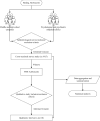Non-suicidal self-injury behaviours among adolescents in Beijing: protocol for an epidemiological and qualitative exploration
- PMID: 40840978
- PMCID: PMC12374669
- DOI: 10.1136/bmjopen-2025-098873
Non-suicidal self-injury behaviours among adolescents in Beijing: protocol for an epidemiological and qualitative exploration
Abstract
Introduction: Non-suicidal self-injurious behaviour (NSSI) is defined as purposeful self-injury without the intention to die. NSSI has become an important threat to public health among teenagers globally, imposing considerable costs on individuals, families and society. It reflects poor emotional regulation and serves as an early warning sign for suicidal ideation and behaviour. The purpose of this study is to look at the prevalence of NSSI and the risk factors related to it in Beijing's adolescent population.
Methods and analysis: Epidemiological surveys and qualitative interviews will both be used in this study. First, a cross-sectional epidemiological survey with stratified sampling will assess the prevalence, risk factors and variables associated with NSSI among adolescents in Beijing. The survey will include a sample size of at least 1415 adolescents. The significance of emotional control, social support and mental health in NSSI conduct will then be investigated through qualitative interviews. This part of the study will use a phenomenological qualitative research approach, with the sample size determined by data saturation, typically around 10 participants, but flexible due to the large sample from the epidemiological survey. In order to investigate the prevalence of NSSI, statistical analysis of correlation, descriptive statistics and regression analysis with multiple variables will be used to analyse the survey data using SPSS V.27.0 and Excel 2003. NVivo V.12 software will be used to code the qualitative data, and thematic analysis and word frequency will be used to find connections between the various NSSI experiences.
Ethics and dissemination: The Guang'anmen Hospital Ethics Committee of the China Academy of Chinese Medical Sciences has given its approval to the project (no. 2023-259-KY). Participants will provide both verbal and written informed consent prior to participation, with legal guardians signing for the qualitative part of the study. Participants will be informed of their right to withdraw from the study at any time without affecting their clinical care. Results will be shared through academic journals, conferences and public health platforms to raise awareness of NSSI and inform related policy development.
Trial registration number: ChiCTR2400085968.
Keywords: adolescents; epidemiologic studies; mental health; qualitative research; suicide & self-harm.
© Author(s) (or their employer(s)) 2025. Re-use permitted under CC BY-NC. No commercial re-use. See rights and permissions. Published by BMJ Group.
Conflict of interest statement
Competing interests: None declared.
Figures


Similar articles
-
Prescription of Controlled Substances: Benefits and Risks.2025 Jul 6. In: StatPearls [Internet]. Treasure Island (FL): StatPearls Publishing; 2025 Jan–. 2025 Jul 6. In: StatPearls [Internet]. Treasure Island (FL): StatPearls Publishing; 2025 Jan–. PMID: 30726003 Free Books & Documents.
-
Prevention of self-harm and suicide in young people up to the age of 25 in education settings.Cochrane Database Syst Rev. 2024 Dec 20;12(12):CD013844. doi: 10.1002/14651858.CD013844.pub2. Cochrane Database Syst Rev. 2024. PMID: 39704320
-
Adverse Childhood Experiences and Nonsuicidal Self-Injury and Suicidality in Chinese Adolescents.JAMA Netw Open. 2024 Dec 2;7(12):e2452816. doi: 10.1001/jamanetworkopen.2024.52816. JAMA Netw Open. 2024. PMID: 39786403 Free PMC article.
-
Prevalence and Correlates of Non-Suicidal Self-Injuring Youth Who Do Not Endorse Suicidal Ideation: Prévalence et corrélation de l'automutilation non suicidaire chez des jeunes qui n'ont pas d'idées suicidaires.Can J Psychiatry. 2025 Jul;70(7):574-582. doi: 10.1177/07067437251337609. Epub 2025 May 15. Can J Psychiatry. 2025. PMID: 40370084 Free PMC article.
-
Research Review: Sex differences in the clinical correlates of nonsuicidal self-injury in adolescents - a systematic review.J Child Psychol Psychiatry. 2025 Aug;66(8):1263-1273. doi: 10.1111/jcpp.14114. Epub 2025 Jan 18. J Child Psychol Psychiatry. 2025. PMID: 39825677 Free PMC article.
References
MeSH terms
LinkOut - more resources
Full Text Sources
Medical
